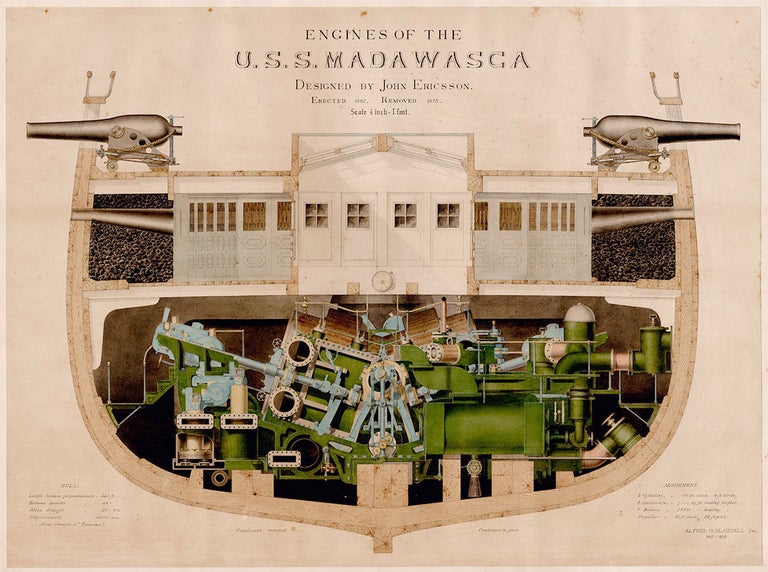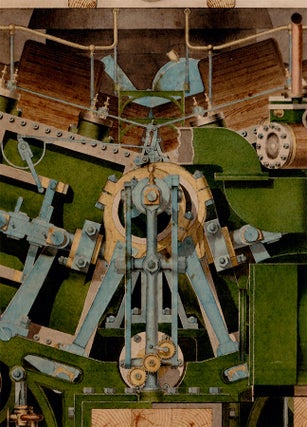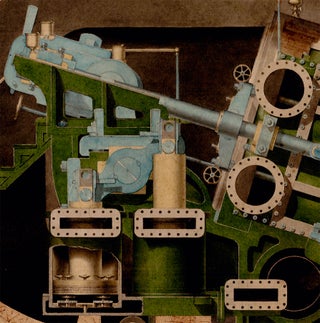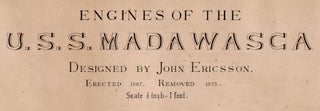Engines of the U.S.S. Madawasca. Designed by John Ericsson. Erected 1867. Removed 1873.
[Brooklyn, NY], 1867–1883. Ink and watercolor, 18.625” x 25.125” plus margins. In original blond oak frame with gold liner. An extraordinary ink and watercolor rendering depicting the engines and other parts of the USS Madawasca, by draftsman Alfred Blaisdell. The engines of the Madawasca were designed by Swedish-American engineer John Ericsson, best known as the designer of the ironclad USS Monitor, and widely considered the greatest mechanical engineer of the nineteenth century. The vessel is shown in a cut-away view of the stern, revealing the engines, in all their ingenious and colorful complexity, and showing as well the cabin and two cannons mounted atop the deck. Blaisdell was employed at the Brooklyn Naval Shipyard, where the Madawasca was built. The immediate occasion for the drawing, as the title indicates, was the replacement of its engines in 1873. The dates following Blaisdell’s signature, 1867–1883, suggest that he was closely involved with the Madawasca over many years, and perhaps worked on the drawing periodically. Clearly created as a display piece commemorating an important naval ship, it is also a striking homage to Ericsson’s genius. John Ericsson (1803–1889) was born in Värmland, Sweden, the son of mining supervisor Olaf Ericsson and Britta Sophia Yngstrom, a woman of Flemish-Scotch descent. His gift for engineering, which revealed itself at an early age, was discovered by Baltzar von Platen, the architect of the Göta Canal, resulting in Ericsson’s employment as a surveyor on the canal project at the age of fourteen. Subsequently, Ericsson joined the Swedish Army. During this time he developed a strong interest in heat engines. In 1826 he moved to England, where he made significant contributions to steam propulsion for trains and ships, including his invention of the twin screw propeller. Disappointed with the lack of encouragement by the British Admiralty, he moved to New York in 1839. While working for shipbuilder Robert Stockton, he incorporated his new propeller into the USS Princeton, which won a speed trial against the SS Great Western, considered the fastest steam vessel in the world at the time. During the Civil War, Ericsson was one of several engineers to submit plans to the navy for an ironclad battleship. When his plans were rejected, he appealed directly to President Lincoln, who approved the design. The ironclad Monitor was built in one hundred days—a remarkable achievement—and proceeded immediately to Hampton Roads, Virginia, to challenge the Confederate ironclad CSS Virginia (formerly the USS Merrimack), which was destroying vessels in the Union Blockading Squadron. On March 9, 1862, the two ships fought to a stalemate in the first-ever battle between two ironclads. This brought to an end the Confederate attempt to break the blockade. Ericsson had incorporated a revolving gun turret into the Monitor—the first of its kind ever built—and this proved a revolutionary innovation, serving the ship well during the battle. Subsequently, the Navy built numerous ironclads, with both single and twin turrets. Revolving guns remain a feature on naval vessels today. The Madawasca, another Civil War era vessel, was the product of Ericsson’s intense focus on steam propulsion for ships, as noted by John Lord: “Throughout his entire career the improvement of the steam-engine occupied a large share of Ericsson’s attention, and in particular was this the case in connection with his naval designs. From the ‘Princeton,’ in 1841, to the ‘Destroyer,’ in 1878, there succeeded one long series of types and forms of steam-engine, each in his opinion the best adapted to the circumstances of the case. Naturally, opinions differ, and he was brought into competition with other able engineers, and his designs were often called into question or subjected to criticism. In 1863, in competition with Chief Engineer Isherwood of the Navy, engines were designed for twin ships, the ‘Madawaska,’ afterward known as the ‘Tennessee,’ and the ‘Wampanoag,’ afterward called the ‘Florida.’ This was a battle royal of types and modes of application of the power of the steam-engine to the propulsion of ships. The result was a victory for Isherwood, although the ‘Madawaska,’ which was first subjected to trial, made a speed higher than any warship at that time afloat. This was exceeded by the ‘Wampanoag’ a short time later; but neither engine was of an enduring type, and after a time the machinery of the ‘Madawaska’ was removed, and she was repowered with a later type of machinery, and long did service as the ‘Tennessee’ in the list of wooden frigates of the navy.” In fact, the Tennessee served as the flagship for both the Asiatic Squadron and the North Atlantic Squadron. Biographical information on Alfred O. Blaisdell (1833–?) is scant, but he seems to have spent his childhood years in Haverhill , Massachusetts, or thereabouts, and lived in Brooklyn, New York for much of his adult life, working for many years as an engineer at the Naval Shipyard. An internet genealogy search reveals that Blaisdell’s maternal grandfather, John Osgood (1770–1840) of Haverhill, Mass., was a silversmith and clockmaker. It would appear that Blaisdell inherited his mechanical and artisanal ability. A marvel of mechanical draftsmanship bearing witness to Ericsson’s genius, and a striking emblem of ascendant American naval power in the years immediately following the Civil War. REFERENCES: Church, William Conant. The Life of John Ericsson, pp. 187–190; Durand, W.F. “John Ericsson: Navies of War and Commerce” in: Lord, John. Beacon Lights of History, Vol. XIV, (NY 1894); From the Archives Center, National Museum of American History at amhistory.si.edu: “Alfred O. Blaisdell, 268 Clermont Ave., Brooklyn, NY – Technical notes and drawings on various marine engineering problems; also notes on electricity, early aviation (Wright Brothers), telescopes, and religion, ca. 1899–1912.”
Item #2533
Sold






